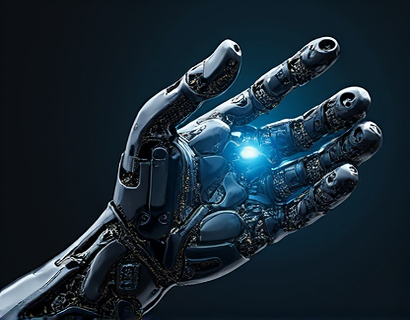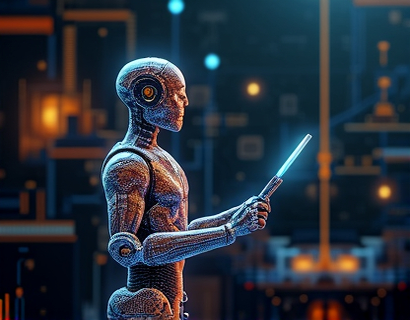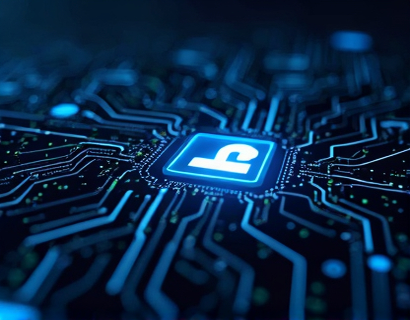Transforming Digital Experiences: The Synergy of Crypto and AI
The intersection of blockchain technology and artificial intelligence (AI) is ushering in a new era of digital transformation. This synergy is not just about combining two powerful technologies but about creating a paradigm shift in how we interact with digital systems. The integration of blockchain and AI is set to revolutionize various sectors, from finance and healthcare to entertainment and beyond. This article explores the transformative potential of this combination, focusing on how it can enhance digital experiences and drive substantial growth and engagement in the tech landscape.
Understanding Blockchain and AI
Before delving into their integration, it's essential to understand the fundamentals of both technologies. Blockchain is a decentralized ledger technology that ensures transparency, security, and immutability in transactions. It operates on a peer-to-peer network, eliminating the need for intermediaries and reducing the risk of fraud. On the other hand, AI refers to the simulation of human intelligence processes by machines, particularly computer systems. These processes include learning (the acquisition of information and rules for using it), reasoning (using rules to reach approximate or definite conclusions), and self-correction.
When combined, blockchain and AI leverage their unique strengths to create robust and efficient systems. Blockchain provides a secure and transparent environment for AI algorithms to operate, ensuring data integrity and trust. AI, in turn, enhances the functionality of blockchain by analyzing vast amounts of data to optimize processes, predict trends, and automate tasks.
The Transformative Power of Blockchain in Digital Interactions
Blockchain technology has the potential to fundamentally change digital interactions by providing a trustless and decentralized framework. In traditional digital systems, trust is often placed in central authorities or intermediaries, which can be points of failure and vulnerability. Blockchain removes this dependency by distributing trust across a network of nodes, each maintaining a copy of the ledger.
One of the most significant impacts of blockchain in digital interactions is in the realm of identity verification. Traditional identity systems are centralized and prone to breaches and misuse. Blockchain-based identity solutions offer a decentralized approach where users have control over their personal data. This not only enhances privacy but also reduces the risk of identity theft. For instance, a user can grant specific permissions to a service provider to access certain aspects of their identity without revealing unnecessary information.
Another area where blockchain shines is in supply chain management. By recording each transaction on a blockchain, companies can ensure transparency and traceability. This is particularly useful in industries like pharmaceuticals and luxury goods, where authenticity and provenance are critical. AI can further enhance this by analyzing blockchain data to predict supply chain disruptions, optimize inventory, and improve overall efficiency.
AI Enhancing Blockchain Functionality
AI's role in enhancing blockchain goes beyond mere data analysis. AI algorithms can be used to optimize blockchain networks, making them more efficient and scalable. For example, AI can help in designing more effective consensus mechanisms, reducing the computational power required for validating transactions. This not only lowers the energy consumption of blockchain networks but also makes them more accessible and sustainable.
Smart contracts, a cornerstone of blockchain technology, can be significantly improved with AI. Smart contracts are self-executing contracts with the terms of the agreement directly written into code. However, they are limited by their predefined rules and lack the flexibility to adapt to changing conditions. AI can introduce a layer of intelligence to smart contracts, enabling them to make decisions based on real-time data and complex scenarios. This can revolutionize areas such as insurance, where AI-driven smart contracts can automatically process claims based on verified data from IoT devices.
Enhancing User Experience through AI-Powered Blockchain Applications
The combination of blockchain and AI is not just about backend efficiency; it's also about creating superior user experiences. AI can analyze user behavior and preferences to personalize interactions on blockchain-based platforms. For instance, in decentralized finance (DeFi), AI can help users find the best investment opportunities by analyzing market trends and providing personalized recommendations. This level of personalization enhances user engagement and satisfaction, leading to higher adoption rates.
Another application is in the realm of customer support. AI-powered chatbots integrated with blockchain can provide seamless and secure support services. These chatbots can handle a wide range of queries, from transaction confirmations to identity verification, all while maintaining user privacy and data security. The immutable nature of blockchain ensures that all interactions are recorded and transparent, building trust between users and service providers.
Driving Growth and Engagement with Blockchain and AI
The synergy of blockchain and AI can drive substantial growth and engagement in various industries. In the gaming sector, for example, blockchain can ensure fair play and ownership of in-game assets through non-fungible tokens (NFTs). AI can enhance this by creating dynamic and adaptive game environments, personalized to each player's preferences and skills. This not only increases player engagement but also opens up new revenue streams for game developers.
In the healthcare industry, blockchain can secure patient data and ensure its integrity, while AI can analyze this data to provide insights for better diagnosis and treatment. AI-driven predictive analytics can identify potential health risks based on blockchain-verified patient histories, enabling proactive healthcare management. This integration can lead to more efficient and effective healthcare services, improving patient outcomes and satisfaction.
Challenges and Considerations
Despite the immense potential, the integration of blockchain and AI is not without challenges. One of the primary concerns is scalability. Blockchain networks, especially those using proof-of-work consensus mechanisms, can struggle with high transaction volumes. AI can help mitigate this by optimizing network operations and developing more efficient consensus algorithms. However, ongoing research and development are necessary to address these scalability issues.
Another challenge is regulatory compliance. The decentralized nature of blockchain and the complex algorithms of AI can complicate regulatory frameworks. Ensuring that these technologies comply with existing laws and regulations, while also advocating for new frameworks that support innovation, is crucial. Collaboration between technologists, policymakers, and industry stakeholders is essential to navigate these regulatory landscapes.
Future Prospects
The future of blockchain and AI is bright, with numerous possibilities on the horizon. As technology advances, we can expect more seamless integration and innovative applications. For instance, the development of interoperable blockchain networks will allow different systems to communicate and share data more effectively. AI will play a key role in managing and optimizing these networks, ensuring smooth and secure interactions.
Moreover, the rise of edge computing, which brings computation closer to the data source, will complement blockchain and AI by reducing latency and improving response times. This is particularly beneficial for real-time applications such as autonomous vehicles and smart cities, where immediate decision-making is critical.
In conclusion, the integration of blockchain and AI is poised to transform digital experiences, driving growth and engagement across various sectors. By leveraging the strengths of both technologies, we can create more secure, efficient, and personalized digital environments. As innovators and early adopters, embracing this synergy will be key to staying ahead in the rapidly evolving tech landscape.










































